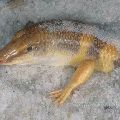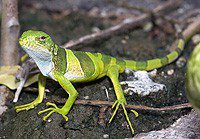
Shabuti
Russian name: Lesnaya, Shabuti, Toothed
Latin name: Geochelone denticulata, Chelonoidis denticulata, Testudo tabulata
Shabuti (Geochelone denticulata) is a reptile of the family of terrestrial turtles. Elongated, flattened carapace, dark brown above with yellow spots (length up to 55-60 cm); in young it is more convex and brighter colored. The head and long thick legs are blackish. Shabouti is widespread in the tropical forests of South America (to the east of the Andes) and the Lesser Antilles. It feeds on fruits and herbs. Eggs (4-12 pieces) are buried in heaps of fallen leaves. The meat and eggs of Shabouti are eaten.
Classification

Kingdom: Animals
Type: Chord
Subtype: Vertebrates
Class: Reptiles
Order: Turtles
Suborder: Hidden-necked turtles
Family: Land turtles
Genus: American tortoises
View: Forest
Inhabitation
Shabouti can be found in the tropical forests of South America east of the Cordillera, in the Lesser Antilles, on the island of Trinidad. Inhabits swamp forests, cool rivers in wooded areas, farms and grasslands. Stays close to water during breeding season.
Description
This is a large turtle, the length of the shell of which can reach 60 cm. The shell itself is flattened and has an oblong-ovoid shape, expanding at the back. The coloration is dark brown, on each shield there is a yellow blurry spot. The forelegs and neck skin are often red or orange. Males have a concave plastron and a longer tail
Food
These turtles are herbivorous, however, like most terrestrial skulls, they will not refuse a small amount of animal food. They feed on slugs, insects, wild fruits, cabbage, fish, newborn mice. At the end of spring showers, they can be found in plowed fields, looking for worms. However, vegetable food still prevails.
Reproduction

Shabuti lay their eggs between May and June. The clutch contains 4-12 elliptical eggs, about 4 cm long. Turtles bury their eggs in the forest floor, although sometimes they just leave them on the surface. Turtles are born in September-October. In the north, the brood can spend the whole winter in the nest without leaving the surface. At a temperature of 26-30°C, the duration of incubation is 140-160 days. The required humidity is 65-70%.
Content
When kept in a terrarium, the presence of a large drinking bowl is mandatory. Ground – peat or a mixture of sand and earth. The optimum temperature of water and air is 25-27°C. If possible, frequent artificial rain is necessary.
Additionally
This species is listed in the international Red Book, as its meat is eaten by local residents. The species is on the verge of extinction. Shabuti is an excellent climber, she can overcome obstacles up to 1 m high. A turtle is known that has lived in captivity for 8 years.
Thank you projects
http://dic.academic.ru
www.cherepahi.ru
http://ru.wikipedia.org
http://www.floranimal.ru





